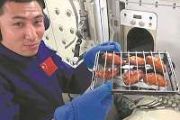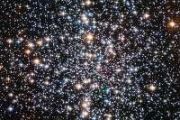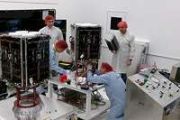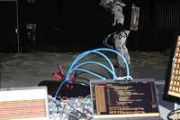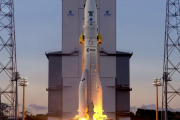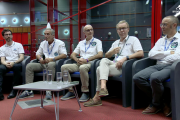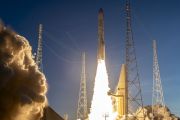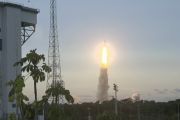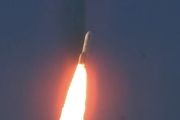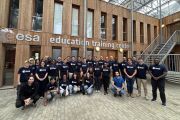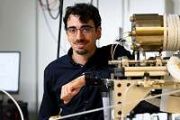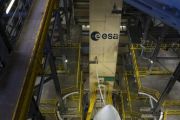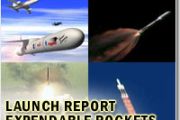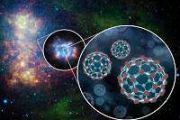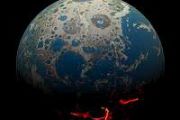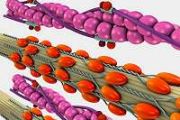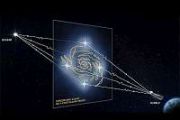
Copernical Team
Physicists propose new insights into dark matter through stellar streams
 Researchers have identified a potential explanation for the unusual features of the GD-1 stellar stream, one of the most thoroughly studied stellar streams in the Milky Way's galactic halo. This thin, elongated stream exhibits distinctive spur and gap characteristics that have puzzled scientists. A team led by Professor Hai-Bo Yu from the University of California, Riverside, suggests these featu
Researchers have identified a potential explanation for the unusual features of the GD-1 stellar stream, one of the most thoroughly studied stellar streams in the Milky Way's galactic halo. This thin, elongated stream exhibits distinctive spur and gap characteristics that have puzzled scientists. A team led by Professor Hai-Bo Yu from the University of California, Riverside, suggests these featu Beyond the Dragon Arc a treasure trove of unseen stars
 Astronomers have captured images of over 40 individual stars in a galaxy so distant that its light has traveled for nearly 6.5 billion years to reach Earth, dating back to when the universe was only half its current age. This achievement was made possible through the combined power of NASA's James Webb Space Telescope (JWST) and a cosmic phenomenon known as gravitational lensing.
The galax
Astronomers have captured images of over 40 individual stars in a galaxy so distant that its light has traveled for nearly 6.5 billion years to reach Earth, dating back to when the universe was only half its current age. This achievement was made possible through the combined power of NASA's James Webb Space Telescope (JWST) and a cosmic phenomenon known as gravitational lensing.
The galax NSF and ISS Lab allocate funding for space research projects
 For the tenth year running, the U.S. National Science Foundation (NSF) is soliciting proposals that utilize the International Space Station (ISS) National Laboratory for advanced research into transport phenomena. This initiative includes investigations into manufacturing methods that employ transport processes and the materials resulting from such techniques. NSF has committed up to $3.6 millio
For the tenth year running, the U.S. National Science Foundation (NSF) is soliciting proposals that utilize the International Space Station (ISS) National Laboratory for advanced research into transport phenomena. This initiative includes investigations into manufacturing methods that employ transport processes and the materials resulting from such techniques. NSF has committed up to $3.6 millio ISS crew prepares for spacewalks and advances scientific research
 The Expedition 72 crew aboard the International Space Station (ISS) is starting the new year with preparations for an upcoming spacewalk aimed at servicing scientific instruments and installing communications equipment. In addition to spacewalk preparations, the crew is engaged in space agriculture experiments and cargo operations.
NASA astronauts are scheduled to exit the ISS's Quest airl
The Expedition 72 crew aboard the International Space Station (ISS) is starting the new year with preparations for an upcoming spacewalk aimed at servicing scientific instruments and installing communications equipment. In addition to spacewalk preparations, the crew is engaged in space agriculture experiments and cargo operations.
NASA astronauts are scheduled to exit the ISS's Quest airl N Space Tech partners with ISRO to launch SwetchaSAT-V0
 N Space Tech, a defence and aerospace startup, has successfully launched its first payload in the SwetchaSAT-Vx series aboard ISRO's PSLV Orbital Experimental Module (POEM-4). This innovative platform, which converts the spent fourth stage of the PSLV rocket into a stable orbital environment, hosted the SwetchaSAT-V0 payload during its deployment from the SHAR centre at Sriharikota as part of IS
N Space Tech, a defence and aerospace startup, has successfully launched its first payload in the SwetchaSAT-Vx series aboard ISRO's PSLV Orbital Experimental Module (POEM-4). This innovative platform, which converts the spent fourth stage of the PSLV rocket into a stable orbital environment, hosted the SwetchaSAT-V0 payload during its deployment from the SHAR centre at Sriharikota as part of IS How US-Indian NISAR Satellite Will Offer Unique Window on Earth
 A Q&A with the lead U.S. scientist of the mission, which will track changes in everything from wetlands to ice sheets to infrastructure damaged by natural disasters.
The upcoming U.S.-India NISAR (NASA-ISRO Synthetic Aperture Radar) mission will observe Earth like no mission before, offering insights about our planet's ever-changing surface.
The NISAR mission is a first-of-a-kind dua
A Q&A with the lead U.S. scientist of the mission, which will track changes in everything from wetlands to ice sheets to infrastructure damaged by natural disasters.
The upcoming U.S.-India NISAR (NASA-ISRO Synthetic Aperture Radar) mission will observe Earth like no mission before, offering insights about our planet's ever-changing surface.
The NISAR mission is a first-of-a-kind dua China incorporates small commercial satellites into weather services
 Two sets of small commercial satellites have been integrated into the China Meteorological Administration's (CMA) weather observation framework. This marks the first time CMA has utilized data from small commercial satellites for its weather services.
The Tianmu-1 constellation, consisting of 23 satellites, and the 12-satellite Yunyao-1 series began contributing data to the CMA on December
Two sets of small commercial satellites have been integrated into the China Meteorological Administration's (CMA) weather observation framework. This marks the first time CMA has utilized data from small commercial satellites for its weather services.
The Tianmu-1 constellation, consisting of 23 satellites, and the 12-satellite Yunyao-1 series began contributing data to the CMA on December Some bacteria evolve in seasonal cycles like clockwork
 Bacteria in Wisconsin's Lake Mendota demonstrate a unique pattern of evolution, with species adapting to dramatic seasonal changes and then reverting genetically to prior states over time. According to a study published in Nature Microbiology, researchers found that hundreds of bacterial species evolve in response to shifting environmental conditions yet consistently return to near-identical gen
Bacteria in Wisconsin's Lake Mendota demonstrate a unique pattern of evolution, with species adapting to dramatic seasonal changes and then reverting genetically to prior states over time. According to a study published in Nature Microbiology, researchers found that hundreds of bacterial species evolve in response to shifting environmental conditions yet consistently return to near-identical gen Microbes can colonize space, produce drugs and create energy
 After so many years learning how microbes work, researchers are now digitally recreating their inner workings to tackle challenges ranging from climate change to space colonization.
In my work as a computational biologist, I research ways to get microbes to produce more useful chemicals, such as fuels and bioplastics, that can be used in the energy, agricultural or pharmaceutical industrie
After so many years learning how microbes work, researchers are now digitally recreating their inner workings to tackle challenges ranging from climate change to space colonization.
In my work as a computational biologist, I research ways to get microbes to produce more useful chemicals, such as fuels and bioplastics, that can be used in the energy, agricultural or pharmaceutical industrie Citizen scientists help decipher Jupiter's cloud composition
 Citizen scientists and professional astronomers have collaborated to unveil key details about the composition of Jupiter's clouds. Findings indicate the clouds are likely made of ammonium hydrosulphide mixed with smog, refuting previous theories suggesting they consisted of ammonia ice.
The research, published in the Journal of Geophysical Research - Planets, was initiated by amateur astro
Citizen scientists and professional astronomers have collaborated to unveil key details about the composition of Jupiter's clouds. Findings indicate the clouds are likely made of ammonium hydrosulphide mixed with smog, refuting previous theories suggesting they consisted of ammonia ice.
The research, published in the Journal of Geophysical Research - Planets, was initiated by amateur astro 

